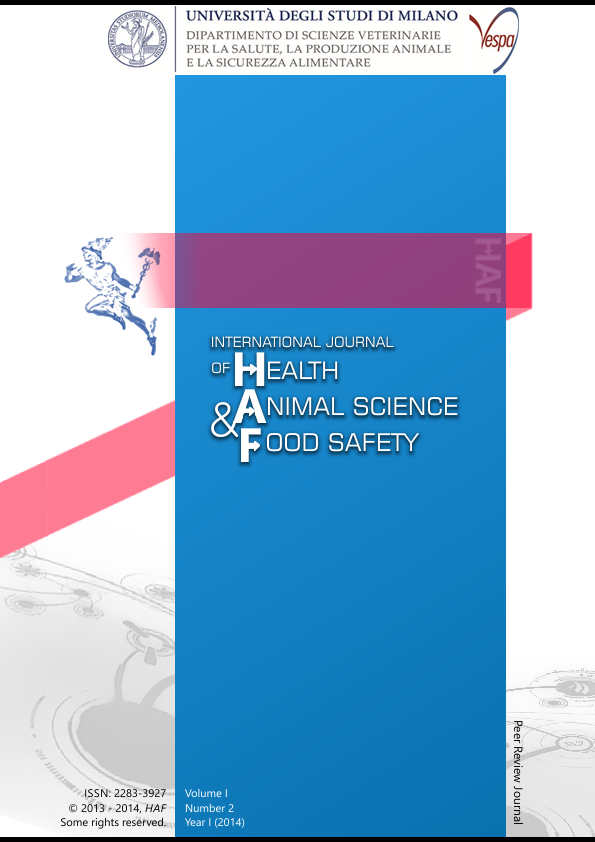Abstract
The study was conducted to investigate residues of three fluoroquinolones (ciprofloxacin, norfloxacin and ofloxacin) in chicken meat sold in Ibadan, Nigeria. Two hundred and ninety-seven (297) samples of imported frozen (99) locally produced frozen (99) and freshly slaughtered (99) broiler chicken meat products were screened for antibiotic residues by microbiological assay using Escherichia coli as test organism. High performance liquid chromatography (HPLC) with ultraviolet (UV) detection was used for the determination of ciprofloxacin, norfloxacin and ofloxacin in the positive samples. One hundred and sixty (160) samples, constituting more than half (53.87%) of total sample size tested positive for Escherichia coli–sensitive antibiotic residues. Positive samples were 54.55%, 56.57% and 52.53%, of freshly slaughtered, locally produced frozen chicken and imported frozen chicken meat respectively. Residues of investigated fluoroquinolones occurred more frequently in locally produced frozen chicken than in imported frozen chicken. The concentrations were however consistently higher in imported chicken. Among the three fluoroquinolones examined, the most abundant in imported frozen chicken was ciprofloxacin with mean 354.83±716.43µg/kg. Norfloxacin was the most abundant in freshly slaughtered and locally produced frozen chicken meat, having mean values of 107.70±138.36µg/kg and 120.96±162.83µg/kgrespectively while ofloxacin was the lowest in all categories. Most frozen chicken products imported into Nigeria at the time of this study contain higher levels of residual fluoroquinolones than the locally produced chicken. In order to tackle fluoroquinolone resistance from a food safety perspective, proper usage and monitoring of fluoroquinolones in meat animals should be encouraged in developing countries.
Riferimenti bibliografici
Aibinu, I., Adenipekun, E. and Odugbemi, T., 2004. Emergence of quinolone resistance amongst Escherichia coli. Nigerian Journal of Health and Biomedical Science. 3(2), 73-78.
Alla, M.B.W., Mohamed, T.E and Abdelgadir, A.E., 2011.
Detection of antibiotics residues in beef in Ghanawa Slaughterhouse, Khartoum State, Sudan African Journal of Food Science Vol. 5(10), 574-58.
Al-Mustafa Z.H. and Al-Ghamdi M. S., 2000. Use of norfloxacin in poultry production in the eastern province of Saudi Arabia and its possible impact on public health. International Journal of Environmental Health Research. 10, 291–299.
Barrow, G. I, Feltham, R.K.A., 1993. Cowan and Steel’s manual for the identification of medical bacteria. London: Cambridge University press.
Cañada-Cañada, F., Espinosa-Mansilla, A., Jiménez, Girón A., Muñoz de la Peña A., 2012. Simultaneous determination of the residues of fourteen quinolones and fluoroquinolones in fish samples using liquid chromatography with photometric and fluorescence detection. Czechoslovakia Journal of Food Science. 30, 74–82.
Commission Regulation (EU) No 37/2010 of 22 December 2009 on pharmacologically active substances and their classification regarding maximum residue limits in foodstuffs of animal origin.
Daini, A., Ogbolu, O. D. and Ogunledun, A., 2005. Quinolone resistance and R plasmids of some Gram negative enteric bacilli. African Journal of Clinical Experimental Microbiology. 6 (1), 14-20.
Daniel, O., Osman, E., Bakare, R., Adebiyi, P., Ige, O., Ogiri, S., Awe, E., Kabir, M., Ogundahunsi, O., Mourad, G. and Declarq, E., 2011. Ofloxacin resistance among Mycobacterium tuberculosis isolates in two states of south-west Nigeria. African Journal of Respiratory Medicine. 23, 18-20.
Dipeolu, M. A., (2010). Healthy meat for wealth. UNAAB Inaugural Lecture Series. 29, 12-49.
Emami, S., Shafiee, A., Foroumadi, A., 2010. Quinolones: recent structural and clinical developments. Iran Journal of Pharmaceutical Research. 4(3), 123-136.
Enabulele, I.O., Yah, S.C., Yusuf, E.O., Eghafona, N.O., 2006. Emerging quinolone resistant transfer genes among gram-negative bacteria, isolated from faeces of HIV/AIDS patients attending some clinics and hospitals in the city of Benin, Edo State, Nigeria. Online Journal of Health and Allied Sciences. 3, 3.
Hernández Serrano P., 2005: Responsible Use of Antibiotics in Aquaculture. FAO, Rome.
Makanjuola, B.O, Bakare, R.A and Fayemiwo, S.A., 2012. Quinolone and Multidrug Resistant Salmonella typhi in Ibadan, Nigeria. International Journal of Tropical Medicine. 7, 103-107.
Naeem, M., Khan, K. and Rafiq, S., 2006. Determination of Residues of Quinolones in Poultry Products by High Pressure Liquid Chromatography . Journal of Applied Sciences. 6(2), 373-379.
Okeke, I.N., Lamikanra, A., Edelman, R. 1999. Socioeconomic and behavioural factors leading to acquired bacterial resistance to antibiotics in developing countries. Emerging Infectious Diseases. 5, 18-27.
Olowe, O.A., Ogungbamigbe, T.O., Kolawole, S.O., Olowe, R.A., and Olayemi, A.B., 2008. Hemolysis production and resistance to fluoroquinolones among clinical isolates of Escherichia coli in Osogbo metropolis, Southwest Nigeria. New York Science Journal. 1(1), 13-16.
Omotayo, R.K. and Denloye, S.A., 2002. The Nigerian Experience On Food Safety Regulations. FAO/WHO Global Forum of Food Safety Regulators Marrakesh, Morocco; GF/CRD Nigeria-1, Agenda Item 4.1a and 4.1b.
Ovando, H.G., Gorla, N., Weyers, A., ugnia, L., magnoli, A., 2004. Simultaneous quantification of ciprofloxacin, enrofloxacin and balofloxacin in broiler chicken muscle. Archivos de Medicina Veterinaria. 36(1), 93-97.
Oyinloye, J.M., Adedeji, O.O., Akeredolu, A.A., Ezekiel, C.N., Babalola, B.T., Obebe, O.O., Nwadike, F.U. and Alatise, F.A., 2014. Comparative in vitro potency of four fluoroquinolones on clinical isolates over a year period. Journal of Clinical Medicine and Research. Academic Journals. 6(1), 5-10.
Petrovic J., Baltic M., Jupic V., Stefanovic S. and Stojanovic D., 2006. Residues of enrofloxacin and its main metabolite ciprofloxacin in broiler chickens. Acta Veterinaria (Beograd). 56 (5-6), 497-506.
Pikkemaat, M.G., Mulder, P.P.J., Elferink, J.W.A., De Cocq, A., Nielen, M.W.F., Van Egmond, H.J., 2007. Food Additives and Contaminants. 24, 8.
Somasundaram, S. and Manivannan, K., 2013. An Overview of Fluoroquinolones. Annual Review & Research in Biology 3(3), 296-313.
Stanier, R.Y., Ingraham, J.L, Eelis, M.L., Painter, P.P., 1986. The Microbial World. 5th ed. New Jersey: Pristice Hall.
World Health Organization, 2009. Report of the First Meeting of the WHO Advisory Group on Integrated Surveillance of Antimicrobial Resistance (AGISAR), 15-19 June Copenhagen Geneva.
World Health Organization, 2011a. Critically important antimicrobials for human medicine. WHO Advisory Group on Integrated Surveillance of Antimicrobial Resistance (AGISAR), 3rd Revision, 5-31.
World Health Organization, 2011b. Tackling antibiotic resistance from a food safety perspective in Europe WHO Regional Office for Europe, Copenhagen, Denmark.
This work is licensed under a CC BY-SA 4.0 international

